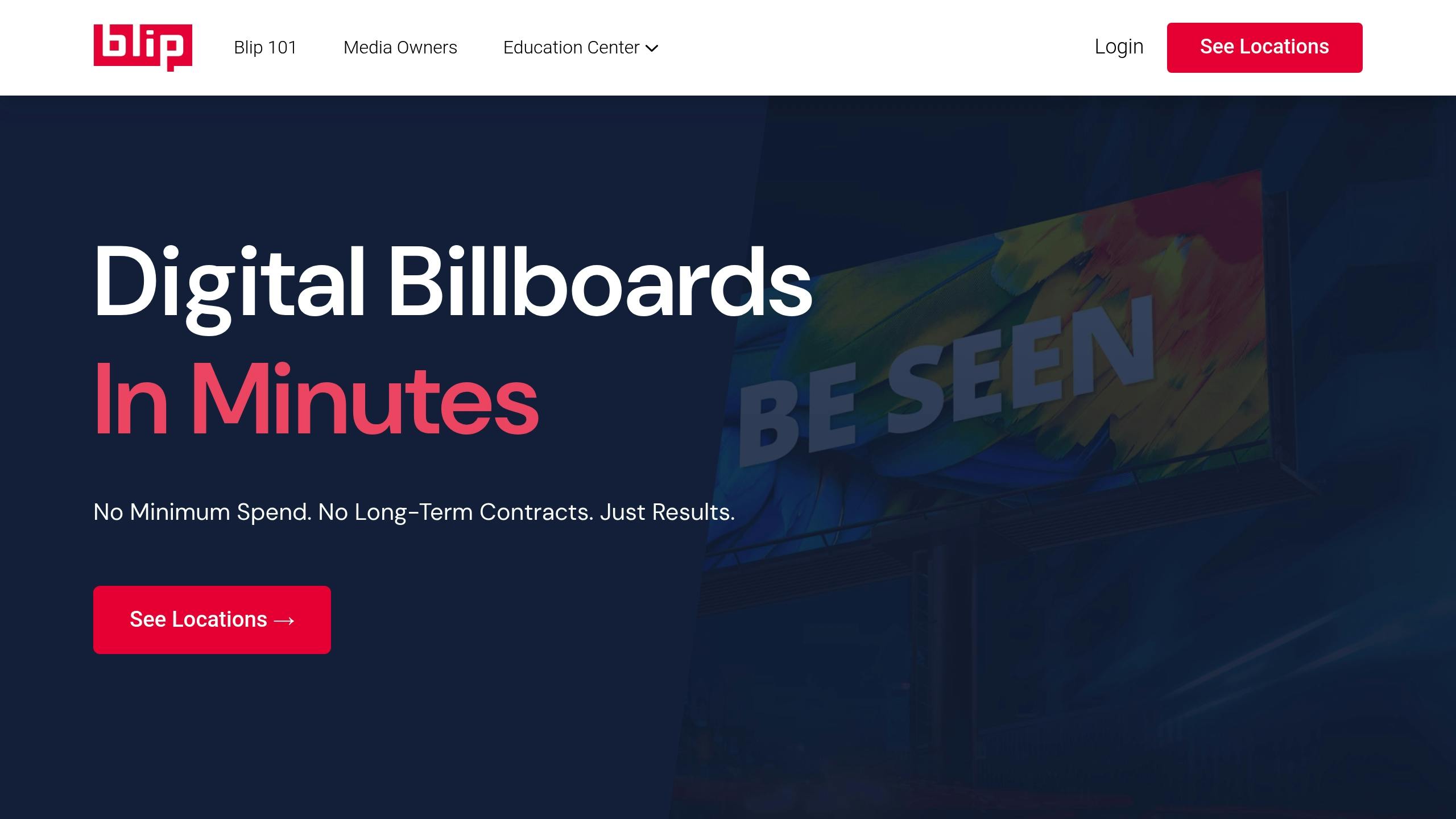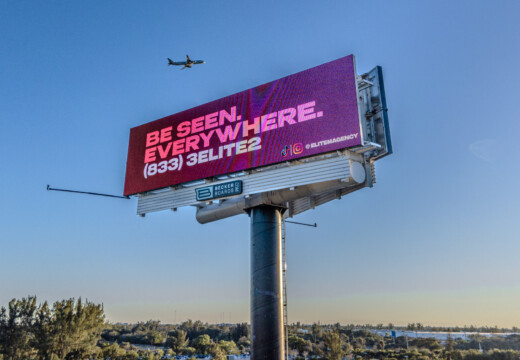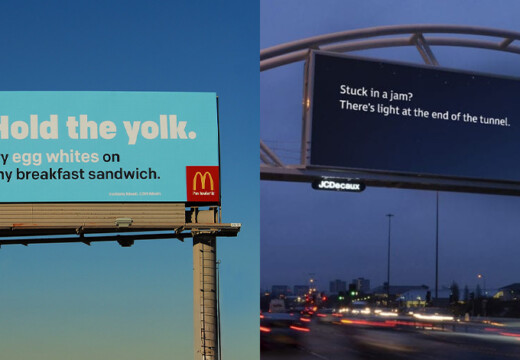Want to grow your small business without overspending on ads? Here are three simple, cost-effective advertising strategies to get started:
- Digital Billboards: Pay-as-you-go advertising starting at $10/day with platforms like Blip.
- Social Media Ads: Reach specific audiences on platforms like Facebook and Instagram with budgets as low as $5/day.
- Local Business Partnerships: Collaborate with nearby businesses to share costs and expand your reach.
These methods are affordable, measurable, and can help increase visibility and revenue.
Quick Comparison
| Advertising Method | Starting Cost | Best For | Key Benefit |
|---|---|---|---|
| Digital Billboards | $10/day | Local visibility | No long-term contracts, flexible |
| Social Media Ads | $5-$20/day | Targeted reach | Precise audience targeting |
| Local Partnerships | Low-Medium | Community presence | Shared resources, mutual benefits |
Pick one or combine strategies to maximize your marketing budget and start seeing results today.
Related video from YouTube
Digital Billboard Advertising with Blip

For years, small businesses have struggled to access digital billboard advertising because of steep costs and long-term contracts. Blip changes the game by offering a flexible, pay-as-you-go model – think of it as Google Ads, but for billboards .
What Are Digital Billboards?
Digital billboards are LED screens that cycle through multiple ads. Unlike traditional billboards, which require manual updates and long-term agreements, digital ones allow for instant content changes.
Blip breaks billboard time into short intervals called "blips", with each blip displaying your ad once. Using a real-time bidding system, advertisers compete for these slots every 10 minutes, keeping pricing dynamic and based on demand .
"The way we describe what we do is that we sell space on digital billboards for the smallest transactional time that exists, which is one display of one ad." – Brent Thompson, CEO of Blip Billboards
How to Launch Your First Blip Campaign
-
Choose Your Locations
Use Blip’s interactive marketplace to browse thousands of billboards across the U.S. Each listing provides useful details like:- Estimated daily impressions
- Average cost per thousand views (CPM)
- Peak traffic hours
- Local demographics
-
Set Up Your Campaign
Define your budget, campaign dates, and preferred display times. -
Design and Submit Your Ad
Upload your artwork following Blip’s design guidelines. The approval process involves:- An initial review by Blip (usually within 90 minutes)
- Approval from the billboard owner (typically 1-3 business days)
Pricing and Performance Tracking
After setting up your campaign, you can track and refine it using Blip’s performance metrics. Here’s what you need to know about costs:
| Cost Component | Details |
|---|---|
| Minimum Daily Budget | $20 |
| Cost Per Display | Starts at $0.01 |
| Contract Length | None – cancel anytime |
| Additional Fees | None – you pay only per display |
Blip’s platform also provides detailed analytics, such as:
- Total number of ad displays ("blips")
- Estimated audience impressions
- Cost per thousand views (CPM)
- Performance by location and time of day
Interestingly, 98% of Blip’s advertisers had never used billboards before, largely due to cost barriers . The platform lets you test different locations, messages, and schedules to find the perfect mix for your business.
sbb-itb-2e2e93f
Social Media Ad Campaigns
Social media ads are a smart way to reach your audience, especially since U.S. adults spend an average of 2.25 hours daily on these platforms . Like digital billboards, they provide a scalable option for small businesses looking to grow.
Selecting Social Media Channels
Different platforms cater to specific audiences and business objectives:
| Platform | Ideal For | Key Metrics | Minimum Ad Budget |
|---|---|---|---|
| Local businesses, B2C | $0.40–$0.70 CPC | $5/day | |
| Visual storytelling, Gen Z | $0.20–$2.00 CPC | $5/day | |
| B2B services | Higher CPC, better B2B targeting | N/A |
Facebook users click on an average of 12 ads per month , while 81% of Instagram users use the platform to research products . To get the best results, focus your efforts on two or three platforms .
Building Strong Ad Content
Creating effective ads involves testing and crafting clear, engaging messages.
"If you go into your ads with a testing strategy – no matter your industry – it will resolve at least 80% of your problems. The other 20% are probably just making sure you have the right strategies specific to your niche or industry in terms of what you’re advertising, such as your offer."
Here’s what works for high-performing ads:
- Use vertical videos and bold fonts
- Add captions and tell a visual story
- Feature your brand within the first 3 seconds
- Include clear calls-to-action
If you’re starting out, consider a Facebook ad budget of $500–$1,500 per month .
Tracking and Improving Results
Keep an eye on these metrics to measure success and refine your campaigns:
| Metric | What It Tells You |
|---|---|
| Engagement Rate | How much your audience interacts |
| Video Completion Rate | Quality and relevance of content |
| Cost per Click | Efficiency of your ad spend |
| Conversion Rate | Your return on investment |
"The comment section is filled with inspiration and feedback, but it’s also a great metric to track as it demonstrates the effectiveness of your posts and the increase in love from your followers." – Trish Riswick, Social Media Manager at Hootsuite
Review your metrics often and adjust your strategy as needed. Businesses using digital marketing have been shown to grow revenue up to 2.8 times faster than those that don’t . To track conversions across platforms accurately, use UTM parameters .
Local Business Partnerships
Collaborating with local businesses can help you reach more people, strengthen community connections, and keep expenses manageable.
Finding Local Partners
Start by identifying businesses that complement what you offer but don’t directly compete with you. Here are some ideas:
- Businesses that serve the same audience as you
- Non-profits that can boost your reputation in the community
- Professional associations that add credibility to your industry presence
- Local groups that increase your visibility in the area
To discover potential partners, check out chamber of commerce meetings, keep an eye on community event calendars, ask your customers where they shop or visit, and attend networking events in your field.
Once you’ve identified potential partners, make sure to define how you’ll work together clearly.
Setting Up Partnership Terms
Clear agreements are key to avoiding confusion and ensuring both sides benefit. Make sure to discuss:
- How resources and costs will be shared
- Who handles what in terms of marketing
- How success will be measured
- Timelines and key milestones
- How you’ll communicate throughout the partnership
Joint Marketing Activities
After nailing down the details, you can kick off joint marketing efforts to reach a broader audience.
| Activity Type | Investment Level | Potential Reach |
|---|---|---|
| Co-branded Content | Low | Online audience |
| Joint Events | Medium | Local community |
| Cross-promotions | Low-Medium | Shared customer base |
| Shared Workshops | Medium | Industry-specific |
These activities not only help you and your partner reach new customers but also strengthen your ties to the local community.
Conclusion
Using digital billboards, targeted social media ads, and local collaborations, your small business can make a big impact without overspending.
Main Points Review
Here’s a quick comparison of the main advertising options for small businesses:
| Advertising Method | Initial Investment | Best For | Key Benefit |
|---|---|---|---|
| Digital Billboards | From $20/day | Local visibility | Flexible with no long-term contracts |
| Social Media Ads | $5-$20/day | Targeted reach | Reaches specific audiences effectively |
| Local Partnerships | Low-Medium | Community presence | Shares resources and costs |
With these options in mind, you can create a focused plan to kick off your advertising efforts.
Getting Started Guide
Start small with your advertising budget. The U.S. Small Business Administration suggests allocating 7-8% of revenue for businesses earning under $5 million annually . Even a 2-3% investment can deliver results if used wisely .
"If you are marketing from a fairly static annual budget, you’re viewing marketing as an expense. Good marketers realize that it is an investment." – Seth Godin
Here’s how to make the most of your initial advertising spend:
- Build a strong online presence first. Ensure your website, social media, and other online platforms are ready before launching paid campaigns.
- Pick the right channels. For example, 40% of Gen Z prefers TikTok and Instagram over Google for search . Align your platform choices with your audience’s habits.
- Track results. Use tools to measure ROI. Start with $500–$1,500 monthly for testing social media ads , then scale up based on performance data.
- Start small and grow. Focus on free or low-cost methods like SEO and organic social media. As you see success, reinvest in the most effective strategies.


